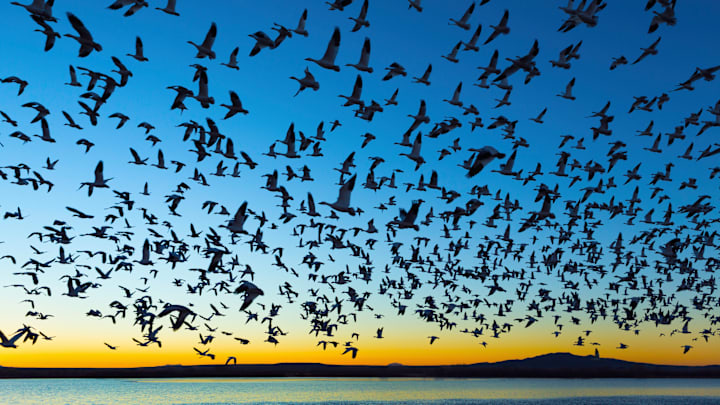Long-distance bird migration is one of the natural world’s most inspiring phenomena—but the story of how we know what we know about bird migration is almost as amazing as migration itself. My new book, Flight Paths: How a Passionate and Quirky Group of Pioneering Scientists Solved the Mystery of Bird Migration, tells that story, profiling the ornithologists, engineers, and other researchers who have worked to uncover migration’s secrets and the innovative methods they’ve developed to do so. Here are nine amazing facts about migrating birds and the people who study them.
1. One early theory about migration was that birds were flying to the moon.
Seventeenth-century minister and educator Charles Morton proposed the theory that birds were traveling to the moon and back when they disappeared and reappeared with the seasons. As wild as that sounds today, some of his ideas hit surprisingly close to the truth—he speculated that changes in weather and food availability might prompt birds to head for greener (more lunar?) pastures, and even guessed that body fat might help sustain them on their journey.
2. The Pfeilstorch was the first hard evidence of migration between continents.

In 1822, a hunter in Germany shot a stork that turned out to have an enormous spear embedded in its neck. Analysis of the wood and iron in the spear proved it was made in Africa, and the unfortunate bird had carried it from one continent to another before meeting its final end. This famous bird, dubbed the Pfeilstorch (German for “arrow stork”), is still on display in the University of Rostock’s natural history museum in Germany.
3. Scientists tried to count migratory birds by “moon-watching.”
Before the dawn of the digital era, scientists had to get creative to spy on migrating birds. One early method was “moon-watching,” using a telescope to count silhouettes of birds passing in front of the full moon [PDF]. Another was recording the calls of birds passing overhead—a pair of scientists working in the 1950s rigged up a tape recorder with bicycle axles to hold the 6000 feet of tape they’d need to record eight hours of calls [PDF].
4. Birds have many ways of navigating during migration.

Experiments with putting birds in planetariums have shown that they can orient themselves using the stars. The position of the sun during the day, the appearance of landmarks below, and some degree of genetic hard wiring all play a role as well. There’s even convincing evidence that birds can sense the alignment of the Earth’s magnetic field—how they do this still hasn’t been proven, but it probably has something to do with quantum physics.
5. Migrating birds reshape their entire bodies.
Long-distance migration requires lots of fuel, and birds preparing for long journeys pack on extra body fat, as much as doubling their pre-migration weight. Their hearts and flight muscles grow larger to power all that flying, and many of their other internal organs shrink temporarily, with portions of their digestive organs being reabsorbed into the body until they’re needed again. If they run out of fat, birds can even burn their own muscles for energy.
6. The world’s longest nonstop bird migration is from Alaska to New Zealand.

In 2007, a bar-tailed godwit—a shorebird roughly the size of a football—was surgically implanted with a satellite transmitter while on its breeding grounds in Alaska. This transmitter let scientists track the bird, dubbed E7, as she embarked on her fall migration. She flew without stopping for eight days, crossing the full breadth of the Pacific Ocean, more than 7000 miles, before touching down in New Zealand. In November 2022, another bar-tailed godwit was tracked while making a nonstop journey of over 8000 miles from Alaska to Tasmania.
7. Not all birds migrate.
Just because birds are famous for migration doesn’t mean they all do it. Migration lets birds take advantage of resource booms that happen at different points on the globe at different times of year, but it also carries serious risks, exposing birds to physical stress and lack of food, predators, severe weather, and other threats. Only about 40 percent of the world’s bird species are migrants, and the rest remain in the same area year-round.
8. Today’s scientists have some super high-tech ways of studying migration.

Nearly every major technological advance of the past century has been harnessed to study bird migration. Today’s ornithologists track birds’ movements using tools including weather radar, high-volume genetic sequencing, isotope analysis, and even artificial intelligence.
9. Migrating birds are in trouble (but you can help).
A landmark study published in 2019 estimated that North America is home to 3 billion fewer birds today than in 1970, a loss of almost 30 percent. However, the team behind the study came up with a list of seven simple actions anyone can take to help birds, including keeping pet cats indoors, adding native plants to your outdoor space, choosing bird-friendly coffee, and reducing plastic use.
